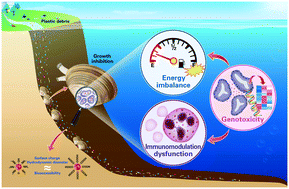Functionalized polystyrene nanoplastic-induced energy homeostasis imbalance and the immunomodulation dysfunction of marine clams (Meretrix meretrix) at environmentally relevant concentrations†
Abstract
The toxic mechanisms of functionalized polystyrene nanoplastics (NPs) in bivalves, especially regarding energy homeostasis and immunity in benthic marine ecosystem, are poorly understood. Therefore, in this study, the toxicity effects of two amino-modified and carboxylated polystyrene NPs (PS-NH2 and PS-COOH) on clams (Meretrix meretrix) at individual, organic, cellular, and gene levels were investigated at environmentally relevant NP concentrations of 0.02–2 mg L−1. The exposure of both NPs showed non-lethal effect but inhibited the clam growth. Little difference in the toxic effect was observed between the two NPs, mainly due to their similar bioaccessibility. The inhibition of clam growth was mainly driven by the energy homeostasis imbalance via the atrophic inflammation of digestive glands induced by the bioaccumulation of NPs. The immunomodulation dysfunction, manifested as decreased phagocytosis resulting from the lysosomal membrane destabilization, was also responsible for the inhibited growth. Furthermore, the mechanisms of genotoxicity were identified to be energy homeostasis imbalance triggered by pancreatic secretion, tricarboxylic acid cycle (TCA) cycle, and peroxisome proliferator activated-receptor α (PPARα) signaling pathway, and the immunomodulation dysregulation dominated by the constrained toll-like receptors (TLR) and nuclear factor-kappa B (NF-κB) signaling pathway, phagosome and lysosome pathway. This work has expanded the current understanding of the toxic mechanisms of functionalized NPs in bivalves, highlighting the potential risks of the NPs in the stability and function of marine benthic ecosystems, even food security.

- This article is part of the themed collections: Nano-bio interactions and SDG14: Life Below Water – Marine Litter (Plastics and Pollution)


 Please wait while we load your content...
Please wait while we load your content...